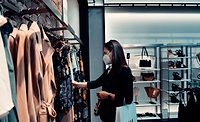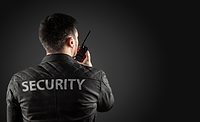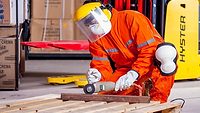In late February 2020, news broke in the United States that the once faraway threat of a “novel coronavirus” had spread to U.S. soil. As COVID-19 case numbers in major cities grew, stay-at-home orders were put in place, businesses closed, restaurants shifted to take-out only, and retailers adopted curbside service. All of this took place to slow the spread of COVID-19.
Meanwhile, however, hospitals remained open — accepting new patients at the direction of the U.S. Center for Disease Control and Prevention (CDC) and working diligently to adhere to new safety guidelines. During virus, or any pandemic outbreaks, we are acutely reminded of our essential frontline healthcare workers, the critical need to enhance their overall safety, security, and to be as efficient as possible when communicating vital information.
Understanding the challenges
With this COVID-19 pandemic has come a host of new challenges for healthcare workers. Hospital staff are now facing daily exposure to the coronavirus when taking temperatures, signing in new patients, and providing care. Not only does all of this virus exposure put the physical health of these workers at risk, but it similarly takes a toll on their mental health and emotional wellbeing, leading to employee burnout and making it difficult to focus on their duties. Additionally, as hospitals tentatively begin the process of re-opening to elective surgeries and other patient care, keeping non-COVID-19 patients separated and free from virus exposure requires extensive logistic planning and action.
Outside of virus exposure and the anxieties that come with it, the National Crime Victimization Survey has shown that healthcare workers are 20 percent more likely to be the victim of workplace violence than any other profession. This unaddressed workplace violence can similarly lead to fear, uncertainty and a lack of safety for staff and also deter patients from wanting to seek care at these facilities, making this critical issue far from an auxiliary cost.
Increasing safety with audio
Healthcare workers’ first lines of defense against COVID-19 begins with a daily briefing, then suiting up in personal protective equipment (PPE). Nurses and doctors don eye protection, face shields, face masks, gowns, gloves and other PPE before entering patient rooms. This process can take significant time, which is an invaluable resource to healthcare workers, especially as many urban hospitals are at or exceeding their capacity. However, even then, every interaction with COVID-19 patients, even with PPE, puts doctors and nurses at risk.
Audio solutions with talk/listen capabilities, like those utilized during previous virus outbreaks, give these workers a tremendous advantage. As an example, in response to the 2014 Ebola epidemic, one New York hospital decided they needed a system that allowed nurses to safely communicate with Ebola patients, without requiring one’s physical presence; in order to save time, when donning and removing protective gear, and conserve PPE. The health care services team quickly set up a cost-effective system using commercial-grade two-way audio devices, located at the nurses’ station and in hospital rooms, that allowed them to speak directly with patients without needing to enter the room.
Two-way, hands-free audio devices installed inside patient rooms, or “hot zones,” allow healthcare workers to remotely consult patients, while also limiting exposure. Fewer in-person interactions reduce the frequency with which staff must put on PPE, which saves time and resources. While quarantined patients still require care — audio solutions give nurses the ability to closely monitor these patients’ conditions and respond to questions, without needing to enter the room unless absolutely necessary.
By reducing the number of close contact interactions with patients, two-way audio solutions also help to lower healthcare worker stress and anxiety levels, which have proven to be one of the unspoken post-traumatic effects of being a medical worker on the frontline. According to Dr. Jessica Gold, an assistant professor of psychiatry at Washington University, many healthcare workers are finding themselves anxious and afraid.
Aggression prevention through audio analytics
In addition to a hands-free two-way audio solution, the advent of audio analytics, like threat detection, can be especially useful for waiting areas that hold people whose frayed nerves are compounded by personal or familial health issues. If a patient has an outburst, audio analytics can alert security professionals to the rising levels of vocal aggression, allowing them to swiftly intervene before the situation escalates.
These analytics can similarly be used in behavioral wards, where patients may be a danger to themselves or others. In these cases, patients can be monitored remotely via two-way audio devices for any sounds of distress allowing medical professionals to intervene when necessary.
Monitoring compliance
When deploying audio devices, it is important to keep compliance measures in mind. Beyond simply installing the solutions, it is important to post visible signage placed in areas where monitoring will take place as this removes the expectation of privacy Not only does this inform healthcare staff and patients but it can also serve as a warning to potential offenders. In addition to signage, it is important to keep in mind that audio monitoring is not the same as audio recording. If your solution is only used for live monitoring, audio devices can go places that video surveillance cannot, such as patient rooms.
Looking forward
Healthcare workers continue to be at risk of exposure to infectious diseases. Comprehensive security and safety solutions that include two-way audio devices help to mitigate these risks while helping staff provide an optimal level of patient care. Audio is part of the long-term solution to protect doctors, nurses and medical assistants and maximize their peace of mind and wellbeing while on the job.




